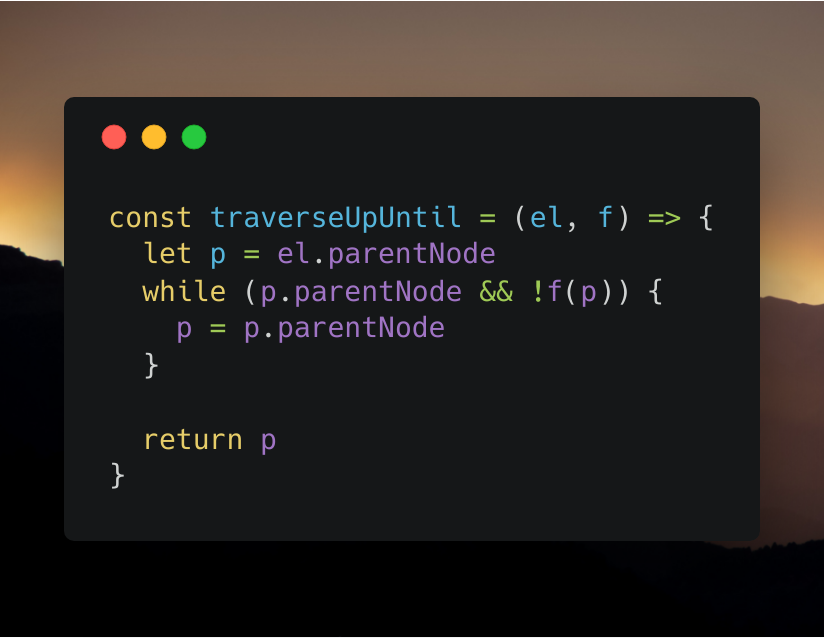How to Make Your Code Readable
How Do You Identify Bad Code?
The simplest way to identify bad code, in my opinion, is to try to read your code as if it were a sentence or phrase.
Here, for example, is some bad code:


The function pictured above, when passed an element and a conditional function, returns the nearest “parent” node that passes the conditional function.
const traverseUpUntil = (el, f) => {Following the idea that code should be as readable as regular writing, the first line has three fatal flaws.
The parameters for the function are not readable like words.
- While
elcan be understood as it is commonly used to meanelement, the parameter namefdoes not explain its purpose. - If you were to use the function, it would read, “traverse up until el passes f,” which could probably be better understood as “traverse up until f passes, from el.” Granted, the best way to actually do this would be to allow the function to be called
el.traverseUpUntil(f)— but that’s a different problem.
In the second line,let p = el.parentNode, we again have a naming issue, this time with a variable. If one were to look at the code they would most likely understand whatp is. It is the parentNode of parameter el. However, when we look at p used anywhere else, we no longer have the context that explains what it is.
while (p.parentNode && !f(p)) {In this line, the main problem we encounter is not knowing what !f(p) means or what it does, because fcould mean anything at this point. What the person reading the code is supposed to understand is that !f(p) is a check to see if the current node passes the condition. If it does, stop the loop.
p = p.parentNode
This one is pretty self-explanatory.
return p
Due to the bad variable name, a reader can’t feel 100 percent clear about what is being returned.
Make Improvements


First we modify the parameter names and their order:(el, f) => into (condition, node) => (you can also do condition => node => which adds an extra layer of useability).
You might be wondering why instead of using “element” I used “node.” I used it for the following reasons:
- We are already writing code in terms of nodes, such as
.parentNode, so why not make it consistent. - Using node is shorter than writing element, but doesn’t sacrifice any meaning. This works with all forms of nodes that have the property “parentNode,” not just HTML elements.
Next, we touch up on the variable name(s).
let parent = node
It’s very important to fully elaborate the meaning of your variable within its name.For example, “p” is now “parent.” You may have also noticed we aren’t starting out by getting node.parentNode. Instead, we only get node.
This leads us into our next few lines.
do { parent = parent.parentNode} while (parent.parentNode && !condition(parent))Instead of a regular while loop, I’ve opted for a do … while loop. This means that we only have to get the “parent” node once, as it runs the condition after the action, not the other way around. The use of the do … while loop also fits the rule of being able to read the code like writing.
Let’s try reading it: “Do parent equals parent’s parent node while there is a parent node and the condition function doesn’t return true.” While that sentence may seem a bit weird, it is more easily read as writing and helps us understand what the code means.
return parent
While many people opt to use the generic ret variable (or returnValue), it is not a good practice to name the variable you return “ret.” If you name your return variables appropriately, what is being returned becomes more obvious. However, sometimes functions can be long and daunting, causing the code to be more confusing. In this instance, I would suggest splitting your function into multiple functions, and if it’s still too complicated, adding comments can help.
Simplify the Code
Now that you’ve made the code readable, it’s time to take out any unnecessary code. As I’m sure some of you have already noticed, we probably don’t need the variable parent at all.
const traverseUpUntil = (condition, node) => { do { node = node.parentNode } while (node.parentNode && !condition(node)) return node}What I’ve done is take out the first line and replace “parent” with “node.” This bypasses the unnecessary step of creating “parent” and goes straight to the loop.
But what about the variable name?
While “node” isn’t the best descriptor for this variable, it’s a decent one. But let’s not settle for decent, let’s rename it. How about “currentNode”?
const traverseUpUntil = (condition, currentNode) => { do { currentNode = currentNode.parentNode } while (currentNode.parentNode && !condition(currentNode)) return currentNode}That’s better! Now when we read it we know that no matter what, currentNode will always represent the node we are currently at instead of it just being some node.
